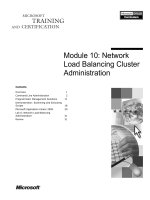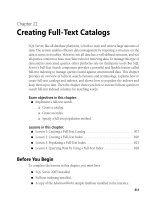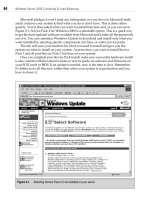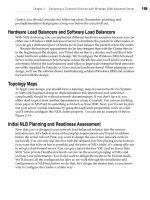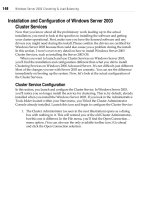Server Load Balancing phần 10 pdf
Bạn đang xem bản rút gọn của tài liệu. Xem và tải ngay bản đầy đủ của tài liệu tại đây (589.32 KB, 20 trang )
Sample Configurations
The purpose of this appendix is to provide a quick reference guide to the multi-
tude of possible load-balancing configurations and implementations available. All
diagrams are vendor-neutral, and a specific product may require slight changes.
Not all vendors will support all configurations, so be sure to check the manual or
the vendor if you are not sure.
Virtually all load balancing can be classified by using this simple matrix in
Figure C-l:
Figure C-l. An SLB implementation matrix
Each configuration falls under one of each of the three columns. Not all combina-
tions work, but this matrix should greatly simplify how load-balancing implemen-
tations are classified and represented no matter what product is used.
All of the figures presented here involve redundancy so that any unit in the config-
uration could fail without an interruption of service. Redundancy in a given sce-
nario can often depend on the other equipment in a configuration, so keep in
mind that these figures do not represent the only way to achieve full redundancy.
157
C
158
Appendix C: Sample Configurations
Flat-Based Topologies
Flat-based scenarios involve IPs of the VIPs and real servers on the same subnet.
They are so named because of the flat-type subnet topology they use. Figure C-2
shows the possible scenarios available with the flat-based topology in white, with
variations that don't work in gray.
Figure C-2. Aflat-based matrix
There are two primary methods for implementing flat-based SLB: bridge-path and
route-path.
Flat-Based, Bridge-Path, Two-Armed
The configuration shown in Figure C-3 is common with the switch-based load bal-
ancers. It involves the load balancer in the Layer 2 path of the return traffic. This
type of configuration utilizes flat-based SLB exclusively, not allowing for any type
of NAT-based configuration. Redundancy is an issue because there cannot be
more than one Layer 2 path in the configuration. One load balancer must be inac-
tive and must not forward Layer 2 traffic.
The default route for the servers is the IP address on the router, where access is
provided to the Internet, so there is no need for a floating IP between the load
balancers other than VIP addresses. This type of configuration is not compatible
with Direct Server Return (DSR). The load balancers act as a Layer 2 bridge
between two separate LANs, while both LANs occupy the same IP address space.
Flat-Based, Route-Path, One-Armed
The type of configuration shown in Figure C-4 is similar to the previous setup
because both utilize flat-based SLB and sit on just one subnet. In this case, how-
ever, the load balancer uses the route-path method because it is in the Layer 3
return for the traffic as the server's default route. The load balancer's default route
Flat-Based Topologies
159
Figure C-3. Aflat-based, bridge-path, two-armed SLB implementation
is the router sitting on the subnet, which provides connectivity to the Internet. The
load balancer connects to the Layer 2 infrastructure with only one connection.
Flat-Based DSR, One-Armed
The scenario in Figure C-5 is exactly like the flat-based, route-path, one-armed SLB
implementation except that outbound server traffic does not pass through the load
balancer, only inbound. This setup is not compatible with most cookie-based per-
sistent configurations nor with any Layer 5-7 URL hashing/rewriting configura-
tions. The servers have the VIP address of the load balancer configured on their
loopback interfaces, and their default route is the router sitting on the subnet. This
bypasses the load balancer for outbound traffic.
160
Appendix C: Sample Configurations
Figure C-4. Aflat-based, route-path, one-armed SLB implementation
NAT-Based Topologies
On NAT-based SLB, IPs of the VIPs and real servers are on separate subnets with
the load balancer performing NAT. It is so named because of the NAT from one
subnet to another. Figure C-6 shows the possible combinations available in a NAT-
based SLB configuration in white, with those that are not possible in gray.
NAT-based SLB does not work with bridge-path because it requires Layer 3 func-
tionality to perform the NAT.
NAT-Based, Route-Path, Two-Armed
The NAT-based configuration shown in Figure C-7 involves the load balancer per-
forming NAT between two subnets, usually a publicly routable subnet and a pri-
vate nonrouted (RFC 1918) subnet. The load balancer sits on two VLANs, with one
connection into each. The default route for the servers is the shared IP address on
the active load balancer on the private network (VLAN 2).
NAT-Based Topologies
161
Figure C-5. A flat-based, one-armed DSR implementation
Figure C-6. A NAT-based matrix
162
Appendix C: Sample Configurations
Figure C-7. A NAT-based, route-path, two-armed SLB implementation
NAT-Based, Route-Path, One-Armed
Though not as common, it is possible to do NAT-based SLB with only one connec-
tion to the Layer 2 infrastructure, as shown in Figure C-8. There are two subnets;
however, they all exist on the same LAN. This is topologically identical to the flat-
based, route-path, one-armed scenario.
It is also not common to use DSR with a NAT-based topology. This requires a
Layer 3 device with interfaces on the public and private networks, as does the
load balancer, to forward the already processed packets to the Internet in order to
take the outbound load off the load balancer. Figure C-9 shows this type of sce-
NAT-Based Topologies
163
Figure C-8. A NAT-based, route-path, one-armed SLB implementation
nario with redundancy components removed to better show the concept (but
redundancy is still very possible with this scenario).
It is also possible to implement NAT-based DSR with a one-armed configuration.
The router just needs to be multinetted with both 192.168.0.1 and 10.0.0.1 (the
server's default route) on the same interface. This configuration is shown in
Figure C-10.
164
Appendix C: Sample Configurations
Figure C-9. A NAT-based, two-armed DSR implementation
NAT-Based Topologies
165
Figure C-10. A NAT-based, one-armed DSR implementation
Index
Numbers
7-Layer Model, 14-15
access, WebNS, 103
ACEDirector, 75
ACK packet, HTTP file transfer and, 32
active unit, CSS switches, 101
active-active roles, redundancy and, 18
active-standby roles, redundancy and, 17
adding servers, 8
admin password
Alteon (WebOS), 142
BIG-IP, 150
Ironware, 143
WebNS, 146
administration
CLI, 124-125
WUI, 120-124
algorithms
flexibility and, 8
load-balancing, 22
aliases, IP addresses (Solaris), 152
Alteon, 75
CLI, 76-77
commands, 141-142
configuration, 75, 78
encrypted access, 83-84
flat-based SLB, 84-90
groups, flat-based SLB, 87-88
IP addresses, 78
load-balancing switches, 31
NAT-based SLB, 90-95
network setup, 78-79
passwords, 82
redundancy, NAT-based SLB, 95-98
security, 81-84
switches, Layer 2-7, 75
VIPs (Virtual Servers), 88-90
WebOS, gateway configuration, 80
architecture, 41
devices, 49-50
infrastructure, 46-49
four pack, 47-48
six pack, 48-49
IP address configuration, 43
networks, 51-52
routers, 52
server load balancers, 51
switches, 53
web servers, 52
ArrowPoint (see Cisco)
ASIC (Application Specific Integrated
Circuit) chips, 30
authoritative DNS servers, 6
We'd like to hear your suggestions for improving our indexes. Send email to
167
168
Index
B
BGP (Border Gateway Protocol), 10
BGP-based GSLB, 10
BIG-IP (F5), 30
commands, 149-150
binding IP addresses, DSR, 151
Border Gateway Protocol (see BGP)
bridge-path
flat-based SLB and, 55-56
flat-based SLB implementation, 44
load balancer and, 43
NAT-based SLB and, 64-65
bridging loops, 49
BSDI OS, 30
bypassing load balancer, 27
c
caching, DNS round robin and, 6
Cisco
administration network, 117
ArrowPoint acquisition, 99
content switches, 99
IP addresses, 102
load-balancing switches, 31
NAT-based SLB, 108-114
real servers, 110-111
NVRAM password, 104
protocol redundancy link, 114
redundancy, 114
security, 103-104
serial settings, 101
servers, removing, 106
source groups, 113
SSH series, 104
startup, 101
syncing configurations, 117
CLI (Command Line Interface)
administration, 124—125
Alteon, 76-77
CSS switches, 100-101
ServerIrons, 130-133
(see also WUI)
clustering, 11-12
SLB comparison, 12
vendors, 12
colocation, 22
commands
Alteon (WebOS), 141-142
BIG-IP (F5), 149-150
Ironware, 143-145
WebNS (Web Network
Services), 145-149
concurrent connections, 33
configuration
Alteon unit, 78
DSR,
151
factory
BIG-IP, 149
Ironware, 143
WebNS (ArrowPoint), 145
gateways, Alteon, 80
IP addresses, flat-based SLB versus
NAT-based, 43
loopback interfaces
Linux (DSR), 153
Solaris (DSR), 152
Windows 2000 (DSR), 153-154
NAT-based SLB (F5), 120
networks
NAT-based SLB, 66-70
ServerIrons, 131-132
one-armed, flat-based SLB, 45
samples
flat-based topologies, 158-159
NAT-based, 160-165
synching (Cisco), 117
two-armed, NAT-based SLB, 45
VIPs, NAT-based SLB and, 68
web servers, DSR, 154-155
connections per second, 32-33
HTTP and, 32
three-way handshake, 33
content rules (WebNS), 107
NAT-based SLB, 111
content switches (Cisco), 99
(see also CSS switches)
content-aware distribution, 4
cookie-based persistence, 29
cookies
flexibility
and,
8
OSI Layers 5-7, 14
cross-country latency, GSLB and, 10
crossover technology, 12
CSS switches, 99
active unit, 101
CLI and, 100-101
flat-based
SLB,
104
hard drives and, 99
ports, 101
Index
169
redundancy, 114
WebNS and, 100
D
data center, 22
degradation, switch-based versus
server-based, 37
devices
multipurpose, 49-50
OSI layers, 47
distribution, content-aware, 4
DNS
authoritative DNS servers, 6
IP addresses and, 6
nslookup utility, 5
servers, whois utility, 6
update speed, 7
web site entries, 5
DNS round robin
caching issues, 6
traffic distribution, 7
DNS-based GSLB, 10
DNS-based load balancing, 4-6
DSR (Direct Server Return), 27-29
configuration example, 151
flat-based SLB and, 55, 55-56
IP addresses, binding, 151
load balancers and, 43
enabling, 151
loopback interface, 151
configuration, 152-154
IP alias, 151
MAC address, 28
MAT
and,
27
NAT-based SLB, 64-65
routers, default route, 151
throughput and, 34
VIP source address, 28
web server configuration, 154-155
E
encrypted access, Alteon, 83-84
encryption, WebNS and, 104
ESRP (Extreme Network's Extreme Standby
Router Protocol), 20
Ethernet
frames, OSI Layer 2, 14
hardware addresses, MAC addresses, 27
packets, throughput and, 33
Physical layer (OSI), 14
F
F5's BIG-IP, 119
configuration, 119
flat-based SLB, 125
NAT-based SLB, 126-127
redundancy, 127-128
stateful fail-over, 128
(see also BIG-IP)
factory configuration
BIG-IP, 149
Ironware, 143
WebNS (ArrowPoint), 145
fail-over
Alteon, 142
BIG-IP, 149
Ironware, 143
stateful fail-over, F5 BIG-IP, 128
WebNS, 146
fail-over cable, 21
fail-over scenario, 4
farms, 16
Fast EtherChannel, throughput and, 34
Fast Ethernet, OSI Layer 2, 14
file transfer, HTTP, 32
Firewall Load Balancing (FWLB), 9, 60
firewalls
flat-based SLB
and,
55, 60
limits, 60
NAT-based SLB, 71
(see also FWLB)
flat-based implemenation, bridging-path
and,
44
flat-based SLB
Alteon and, 84-90
bridge-path and, 55-56
CSS switches, 104
DSR and, 55-56
F5's BIG-IP and, 125
firewalls, 55, 60
FTP
and,
55
groups, Alteon, 87-88
implementation, 54-56
IP addresses, configuration, 43
one-armed configuration, 45
owners (WebNS), 107
ports, Alteon, 85-86
170
Index
flat-based SLB (continued)
real servers
Alteon, 86-87, 92
CSS switches, 105-107
reasons to use, 54-55
route-path and, 55-56
routers, setup, 58
security, 60
ServerIrons, 133-134
setup, 58
streaming and, 55
traffic
flow,
57-58
VIPs and, 25, 59
web servers, setup, 59
flat-based topologies, 158-159
flexibility, 8
floating IPs, NAT-based SLB and, 62
Foundry ServerIrons (see Serverlrons)
four-pack, infrastructure, 47-48
FreeBSD OS, 30
FTP (File Transfer Protocol)
flat-based SLB
and,
55
traffic patterns, 35
full-NAT, 29-30
FWLB (Firewall Load Balancing), 9, 60
G
Gbps (Gigabits per second), 34
Gigabit Ethernet, OSI layer 2, 14
GigE, throughput and, 34
Global Server Load Balancing (see GSLB)
groups, 16
flat-based SLB, Alteon, 87-88
NAT-based SLB, Alteon, 93-94
GSLB (Global Server Load Balancing), 9-10
latency, cross-country, 10
redundancy, 10
WANs and, 10
H
health checking, 21
Hot Standby Redundancy, 136-137
HTTP GET, throughput and, 34
HTTP (Hypertext Transfer Protocol)
connections per second, 32
file transfer example, 32
traffice patterns, 35
HydraWEB, 12
/
infrastructure
architecture
four-pack, 47-48
six-pack, 48-49
architecture and, 46-49
load balancers and, 42
networks, 22
colocation, 22
data center, 22
leased lines, 22
Internet, early uses, 4
IP addresses
aliases
loopback interface (DSR), 151
Solaris, 152
Alteon setup, 78
binding, DSR, 151
Cisco, 102
configuration, flat-based SLB versus
NAT-based SLB, 43
DNS
and,
6
floating, NAT-based SLB andl, 62
loopback interface, 27
packets and, 25
VIP
and,
15
IP packets, OSI Layer 3, 14
Ironware commands, 143-145
L
LANs (Local Area Networks), 9-10
NAT-based SLB and, 62
latency, cross-country, GSLB and, 10
Layer 2 (OSI Model), 14
connectivity, infrastructure and, 46
devices, 47
DSR,
27
MAC addresses, 27
STP (Spanning Tree Protocol), 21
Layer 3 (OSI Model), 14
aggregation, infrastructure and, 46
devices, 47
Layers 5-7 (OSI Model), 14
leased lines, networks, 22
Linux, 30
loopback interface configuration,
DSR,
153
load balancers
bridge-path, 43
bypassing, 27
Index
171
DSR
and,
43
enabling, 151
features, adding, 36
network infrastructure and, 42
route-path, 43
server-based, 30
switch-based, 30-31
load balancing (see clustering)
load-balancing algorithms, 22
LocalDirector (Cisco), 30
loopback interface, 27
DSR,
151
IP alias, 151
Linux configuration, 153
Solaris configuration, 152
Windows 2000 configuration, 153-154
loops, bridging loops, 49
M
MAC addresses, 27
DSR process and, 28
mailing lists, xii
master/slave relationship, 17
MAT (MAC Address Translation), 27
Mbps (Megabits per second), 33
MTUs (Maximum Transmittable Units), 14
N
NAT (Network Address Translation), 25
NAT-based SLB
Alteon, 90-95
bridge-path and, 64—65
Cisco, 108-114
DSR and, 64-65
F5's BIG-IP and, 126-127
F5 configuration, 120
firewalls, 71
groups, Alteon, 93-94
implementation, 62-66
IP addresses, configuration, 43
LANs and, 62
network configuration, 66-70
owners (WebNS), 111-113
real servers
Alteon, 92-93
Cisco, 110-111
reasons to use, 65-66
redundancy, 70
Alteon, 95-98
reverse NAT, 113-114
route-path and, 44
routers, 67
security, 70-71
ServerIrons and, 135-136
SLB units, 67
switches and, 69
traffic flow, 66
two-armed configuration, 45-??, 63
VIP configuration, 68
VIPs (Alteon), 94-95
VPN,
71
web servers and, 68
NAT-based topologies, configuration
samples, 160-165
network drop, 23
network stack, operating systems and, 12
network-based traffic, intercepting, 4
networks
administration (Cisco), 117
Alteon setup, 78-79
architecture, 51-52
components, 51-53
infrastructure, 22
colocation, 22
data center, 22
four pack, 47-48
leased lines, 22
load balancers, 42
six pack, 48-49
NAT-based SLB configuration, 66-70
OSI layers, 13-15
protocols, SLB support, 12
ServerIrons configurations, 131-132
nslookup (DNS), 5
NVRAM password, Cisco, 104
O
100 Mbps barrier, throughput, 34
OS (operating system)
BSDI, 30
FreeBSD, 30
Linux, 30
network stack and, 12
OSI layers, 13-15
Layer 1, 14
Layer 2, 14
172
Index
OSI layers (continued)
DSR,
27
MAC addresses, 27
STP (Spanning Tree Protocol), 21
Layer 3, 14
Layer 5-7, 14
Physical layer, 14
server load balancing relation, 14—15
owners (WebNS)
flat-based SLB, 107
NAT-based SLB, 111-113
P
packets
IP addresses and, 25
rewriting, 26
ASIC chips, 30
route, 25-26
routers, 25
UDP-based, 25
parsing URLs, 8
passwords
admin
Alteon (WebOS), 142
BIG-IP, 150
Ironware, 143
WebNS, 146
Alteon, 82
NVRAM, 104
as plain text (Cisco), 103
recovery
Ironware, 143
WebNS, 147
Serverlrons, 131
performance metrics, 32-38
connections per second, 32-33
server-based degradation, 37
switch-based degradation, 37
throughput, 33-34
total concurrent connection, 33
traffic
profiles,
34-36
the wall, 36-38
persistence, 21
cookie-based, 29
Physical layer (layer 1) of OSI Model, 14
ports
CSS switches, 101
flat-based SLB, Alteon and, 85-86
protocol links, redundancy (Cisco), 114
protocols, network SLB support, 12
R
read-only access, 16
WebNS, 103
real servers
flat-based SLB
Alteon, 86-67, 92
CSS switches, 105-107
Serverlrons, 134
NAT-based SLB
Alteon, 92-93
Cisco, 110-111
removing from production
Ironware, 143
WebNS, 146
returning to production
BIG-IP, 149
WebNS, 146
status
Alteon, 142
Ironware, 144
WebNS, 148
(see also services)
recovering passwords
Ironware, 143
WebNS, 147
redirection, 3
redundancy, 4, 16
active-active roles, 18
active-standby roles, 17
Cisco, 114
F5's BIG-IP, 127-128
fail-over cable, 21
GSLB, 10
live machine redundancy setup
(Cisco), 115
load-balancing algorithms, 22
NAT-based SLB, 70
Alteon, 95-98
persistence, 21
Serverlrons, 136-137
service checking, 21
stateful fail-over, 21
switches and, 47
syncing configurations, 117
VRRP, 19-20
removing servers, 8
requests, 4
Resonate, 12
return traffic management, 44
reverse NAT (NAT-based SLB), 113-114
Index
173
re-writing packets, 26
ASIC chips, 30
RF (Radio Frequency) signals, 14
route-path, 44
flat-based SLB and, 55-56
load balancers and, 43
NAT-based SLB, 44
one-armed configuration, 45
routers, 25, 52
default route, DSR, 151
flat-based SLB, setup, 58
four pack, 47-48
NAT-based SLB and, 67
servers, subnet, 156
six pack, 49
VRRP and, 47
s
security
Alteon, 81-84
Cisco, 103-104
firewalls, 60
flat-based
SLB,
60
NAT-based SLB, 70-71
serial settings, Cisco terminal program, 101
server farms, 16
server load balancers, 51
server-based load balancers, 30
Ethernet interfaces and, 67
Serverlrons, 129
BigServerlrons, 129
CLI,
130-133
flat-based SLB, 133-134
NAT-based SLB, 135-136
network configuration, 131-132
passwords, 131
redundancy, 136-137
SSH configuration, 132-133
Telnet, 131
servers, 15
adding/removing, 8
authoritative DNS servers, 6
availability checking, 8
early Internet use, 4
real servers
Cisco, 110-111
removing from production
(Cisco), 106
removing from production
(Ironware), 143
removing from production
(WebNS), 146
returning to production (BIG-IP), 149
returning to production (WebNS), 146
status (Alteon), 142
status (Ironware), 144
status (WebNS), 148
route, subnet, 156
suspended (Ironware), 143
upgrades, 4
web servers, 52
configuration (DSR), 154-155
service checking, 21
services, creating, 105
sessions per second, 32
simplicity in design, 41-42
six pack, infrastructure, 48-49
SLB (Server Load Balancing)
benefits, 8
clustering comparison, 12
defined, 3
example, 24
SLB
units
flat-based SLB, setup, 58-59
NAT-based SLB, 67
Solaris loopback interface configuration,
DSR,
152
source groups (Cisco), 113
SSH series (Cisco), 104
Serverlrons and, 132-133
stability, 8
startup, Cisco, 101
stateful fail-over, 21
F5's BIG-IP, 128
STP (Spanning-Tree Protocol), Layer 2
redundancy, 21
streaming
flat-based SLB
and,
55
traffic patterns, 35
subnet, default route, 156
superuser access, 16
Alteon CLI, 76
WebNS, 103
suspended servers, Ironware, 143
switch-based load balancers, 30-31
VLANs and, 67
174
Index
switches, 53
Alteon, 75
four pack, 47-48
NAT-based SLB, 69
redundancy and, 47
six pack, 49
trunks, 47
(see also content switches (Cisco); CSS
switches)
syncing configurations (Cisco), 117
T
TCP SYN packet, HTTP file transfer and, 32
TCP (Transmission Control Protocol)
HTTP traffic and, 35
OSILayer4, 14
port numbers
VIP
and,
15
port numbers, VIP and, 15
user sessions, open, 33
Telnet
Serverlrons, 131
SSHand, 104
three-way handshake, 33
throughput, 33-34
100 Mbps barrier, 34
DSRand, 34
Ethernet packets, 33
Fast EtherChannel, 34
GigE and, 34
HTTP GET and, 34
transfer rates, 33
topology configuration samples
flat-based, 158-159
NAT-based, 160-165
total concurrent connection, 33
traffic
distribution, DNS, 7
firewall limits, 60
flat-based SLB and, 57-58
intercepting, 3
network-based traffic, 4
NAT-based SLB, 66
redirecting, 3
requests, 4
route, 24
Web traffic ratio, 28
traffic patterns, 34—36
FTP,
35
HTTP, 35
return traffic management, 44
streaming, 35
Web stores, 36
transactions per second, 32
transfer rates, throughput, 33
transferring files, HTTP, 32
trunks, switches, 47
two-armed configuration, NAT-based
SLB,
63
U
UDP
concurrent connections and, 33
OSI Layer 4, 14
port numbers, VIPs and, 15
UDP-based packets, 25
update speed, DNS, 7
upgrades, servers, 4
URL load balancing, OSI Layers 5-7, 14
URL
parsing
flexibility
and,
8
OSI Layers 5-7, 14
user access levels, 16
read-only, 16
superuser, 16
V
vendors, clustering and, 12
version display
Alteon (WebOS), 142
Ironware, 145
VIPs (Virtual IPs), 15
active-active role scenario, 18
addresses, loopback interface and, 27
configuration, NAT-based SLB, 68
flat-based SLB
Serverlrons, 134
setup, 59
flat-based SLB
and,
25
pass-throughs, 68
source address, DSR process and, 28
status
Ironware, 144
WebNS, 148
WebNS
flat-based SLB, 107
NAT-based SLB,
111-113
WUI,
122
Index
175
VIPs
(Virtual Servers), Alteon,
88-90
NAT-based SLB, 94-95 •
VMA (Virtual Matrix Architecture), 37
VPN (Virtual Private Network), NAT-based
SLB
and,
71
VR (Virtual Router), 95
VRID (Virtual Router ID), 95
VRRP (Virtual Router Redundancy
Protocol), 19-20
ESRP and, 20
routers and, 47
w
the wall, 36-38
WANs (Wide Area Networks), GSLB
and,
10
web servers, 52
configuration, DSR, 154-155
flat-based SLB and, 59
NAT-based SLB and, 68
web site resources, xii
web sites, DNS entries, 5
Web stores, traffic patterns, 36
Web traffic ratio, 28
WebNS (Web Network Services)
access levels, 103
administration network, 117
commands, 145-149
content rules, 107
CSS switches and, 100
encryption and, 104
owners
flat-based
SLB,
107
NAT-based SLB, 111-113
WebOS (Alteon), commands, 141-142
whois utility, DNS servers and, 6
Windows 2000 loopback interface
configuration, DSR, 153-154
WUI (Web User Interface)
administration, 120-124
see also CLI (Command Line Interface)
About the Author
Tony Bourke is a private consultant specializing in Unix administration,
networking, and load balancing. He has held positions at SiteSmith, GlobalCenter,
and Digex. Tony has designed and implemented SLB and Unix architectures for
many high-profile and high-traffic web sites. He has published articles in Sys
Admin Magazine, Hostingtech Magazine, and Network World. He is one of the
leading authorities on the topic of Server Load Balancing and frequently speaks at
conferences around the country. He can be reached at
Colophon
Our look is the result of reader comments, our own experimentation, and feed-
back from distribution channels. Distinctive covers complement our distinctive
approach to technical topics, breathing personality and life into potentially dry
subjects.
The animal on the cover of Server Load Balancing is a jacana, a tropical wading
bird. There are eight species of jacana, in six genera. The jacana's most remark-
able physical characteristic is its long toes. In fact, the jacana has the longest toes
(relatively speaking) of any living bird. When in flight, the jacana's toes extend
beyond the tip of the its tail. These long, wide-spread toes enable the jacana to
walk across the floating leaves of water plants, hence, the names "lotus bird" and
"lily trotter," by which some species of jacana are known. As useful as they are
when walking on watery surfaces, the jacana's toes make walking on land very
difficult, and for this reason you will rarely see a jacana walking on solid ground.
For that matter, you will probably never see a jacana at all, as very few of them
are found in captivity. They can be found in fresh-water ponds and swamps in
tropical regions throughout the world. Jacanas feed mainly on insects, small
mollusks, and small fish.
Jacana females are frequently larger than the males and are more aggressive. In
most jacana species, the female mates with more than one male and lays more
than one clutch of eggs per season. There are typically four glossy, "scribbled"
eggs per clutch, laid in nests that float on the water. The male incubates the eggs
and raises the young alone. Jacana chicks can swim and dive immediately after
hatching. The father doesn't feed the young, as they are able to find and digest
their own food, but he does protect and comfort them for the first few months of
life.
Matt Hutchinson was the production editor and copy editor for Server Load
Balancing. Linley Dolby proofread the book. Nicole Arigo and Linley Dolby
provided quality control. Johnna VanHoose Dinse wrote the index.
Emma Colby designed the cover of this book, based on a series design by Edie
Freedman. The cover image is a 19th-century engraving from the Dover Pictorial
Archive. Emma Colby produced the cover layout with QuarkXPress 4.1 using
Adobe's ITC Garamond font.
David Futato designed the interior layout based on a series design by Nancy Priest.
Neil Walls converted the files from Microsoft Word to FrameMaker 5.5.6 using
tools created by Mike Sierra. The text and heading fonts are ITC Garamond Light
and Garamond Book; the code font is Constant Willison. The illustrations that
appear in the book were produced by Robert Romano and Jessamyn Read using
Macromedia FreeHand 9 and Adobe Photoshop 6. This colophon was written by
Clairemarie Fisher O'Leary.
Whenever possible, our books use a durable and flexible lay-flat binding. If the
page count exceeds this binding's limit, perfect binding is used.

